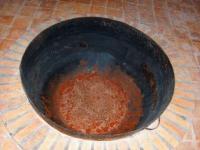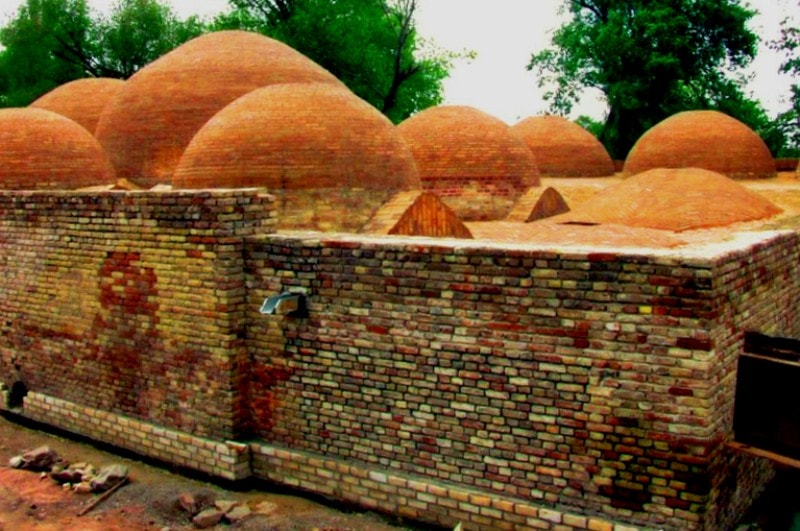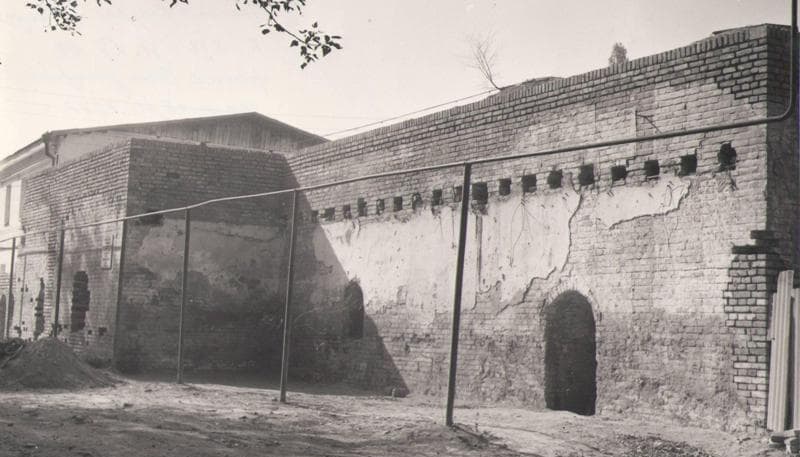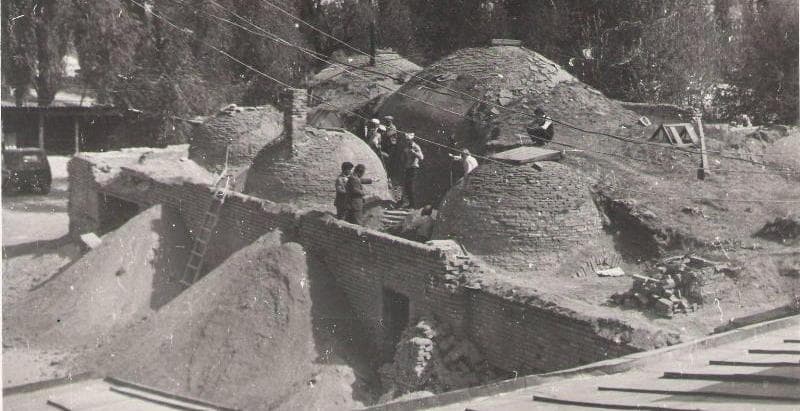Вы здесь
Oriental baths in Kazakhstan.

Cultural walks in Taraz.
“Muslims also need baths, as well as mosques...”
J. Essad.
Excursion to the oriental bath in Taraz.
An oriental bath, like ancient Turkish, is designed to wash the body with the simultaneous action of water and hot air. Baths of this type have been widespread in southern Kazakhstan since ancient times, as evidenced by the discoveries of archaeologists in Taraz, Otrar and other cities located on the ancient Silk Road.
The bathhouse in the eastern city rightfully occupied a prominent place among public buildings, because in the life of the townspeople it played one of the primary roles and after the mosque was the most visited place.
J. Essad wrote: “Baths are also necessary for a Muslim, like mosques ...” In the east, medical postulates of the beneficial effect of the bath on the body were known. In the IX-X century. Zakiriya ar-Razi, describing the effect of the bath on the human body, recommended decorating the bath with a good painting, which heals from melancholy and eases the burden of care.
Baths appeared no earlier than the VIII century. penetrating into Central Asia from the regions of the Mediterranean, i.e. are the “direct descendants” of the ancient, i.e. ancient Roman terms. Baths were discovered during excavations: Afrasiab, Nisa, Tashkent, Taraz, Otrar, Kayalyk.
Baths played an important role in the life of ancient and medieval citizens. They were not only washed, but used to "raise the fallen mood, to relax, to meet and have a friendly conversation with friends, to talk about buying and selling, about a bargain and showing skill in chess and backgammon."
Speaking of ancient and medieval baths, I would like to dwell on the history of the construction of baths. Each nation has its own traditions in the construction of baths and in their use. According to the description of the ancient Greek historian Herodotus, baths of Scythian tribes resembled yurts.
The oblique poles connected by their upper ends were wrapped in woolen felt. In the middle they put a cauldron with water and hot stones were thrown at it. Some Indian tribes of America to this day use the bathhouse, which is a cone-shaped low hut, inside which the earth is deepened, and in the middle there is a hole for heated stones.
The stones are heated at the stake, then they are raked into a hole in a hut and sprayed with water on them. This method has become widespread among tourists and people working on expeditions (geologists, builders, etc.).
People have long been aware of the benefits of a bath. This is due both to the body cleaning process itself, and to the fact that bathing in the bathhouse really has a medically beneficial effect (due to the peculiarities of the structure of human skin, which is equipped with sebaceous and sweat glands).
Exposure to steam and hot water, excessive sweating that appears during the “parks” process stimulate the excretory system of the skin and thereby help the body get rid of toxins and dissolved toxins. The bathhouse was also a hospital.
In the baths themselves, according to sources, they did therapeutic massage and prepared baths with healing solutions. Scientists say that in ancient Greece, the doctor Hippocrates prescribed halfway patients bath procedures.
After the conquests of Alexander the Great in Ancient Greece, and then in Ancient Rome, oriental baths with hot floors spread. The popularity of these institutions among the urban population of the East was great. The message of Ibn Jubair from the XIIth century about baths in the Arab world has survived:
“The care of the Sultan for these newcomers (for training in Alexandria madrasah) extends to the extent that he ordered the baths to be built so that they can wash whenever they need, and founded a hospital for the treatment of those who are sick...
In this blessed city (Mecca), two baths... And each of them (17 quarters of Baghdad) has two or three baths. In this city (Damascus) and its suburbs, there are almost a hundred baths, and there are about forty rooms for bathing; they are all supplied with running water.”
Public baths appeared in the cities of Central Asia not earlier than the eighth century; their appearance and distribution here was undoubtedly a consequence of the inclusion of the Central Asian lands in the Caliphate and the direct cultural ties that arose in this connection with its western regions, where Hellenistic traditions were alive.
In the middle of the IXth century, if not earlier, baths existed in most cities of Central Asia, and in large cities - for example, in Samarkand - there were many of them. Their unexpectedly rapid spread was caused by the cult and domestic legalization of Islam and, not least, by a hot and dry climate.
The Central Asian baths, which retained the Arabic name "hammam", soon turned into one of the important public institutions. This type of architecture has come a long way in Central Asia. This, undoubtedly, was facilitated by the expansion of the scope of use of burnt bricks: saunas built from adobe bricks and butterfields would quickly fall apart if their walls, floors and arches were not covered with a special waterproof coating.
This waterproof solution, called “kyr,” was made from lime, reed ash, and grape molasses. It was difficult to manufacture and, moreover, unreliable: a small hole in the gypsum plaster was enough to make the raw building, filled with hot, moist air and water, begin to collapse.
It can be assumed that the spread of burnt bricks contributed to the wide, and later mass construction of baths in Central Asia. In the stories of X century travelers about the cities of Central Asia, baths are mentioned quite often, with approval or censure.
Al-Mukaddasi found the baths of Bukhara (in many numbers) pleasant, expressed admiration for the famous baths of Merv and Nuzvar, and disapproved of the dirty baths of Nishapur and Tus; Ibn Haukal mentioned the numerous baths of Samarkand.
According to Narshahi, in the Xth century there were several bathhouses in Bukhara, the most famous of which was the “Hamm Khon” (Khan’s bath). By the middle of the XIX century there were already more than 16 baths, in Tashkent during this period there were 11 baths, in Samarkand by the beginning of the XX century there were 8 baths.
In the history of the construction of bathing and bathing facilities, one can trace the general pattern of urban planning techniques. Often, baths were built as part of palace complexes and public buildings located in the city center.
If they were located separately, they were most often located in the municipal economic zone of the city. Baths were private and public. The former were built at the dwellings and were intended for owners and their guests, the latter were distinguished by a larger capacity and, accordingly, a different arrangement, were built by rulers or wealthy citizens, and were paid.
In the XIth - XIIth centuries, revenues from public baths were sometimes bequeathed as waqfs for madrassas and hospitals. In the cities of the Islamic East, public baths - large, richly decorated buildings with massage rooms, relaxation rooms and therapeutic procedures - played the same role as the baths in ancient Rome.
They play it, in general, and now. The materials obtained by archaeologist A.N.Bernshtam during excavations of the bath (XI - XII centuries) of Taraz indicate that in the pre-Mongol period the Central Asian region as a whole was characterized by the ancient tradition.
The baths excavated by the expedition are located at the northeast tower of the citadel. At the end of the excavation, the plan for the construction of the bathhouse was said to be a “hamam”, and the details in the structure and the findings in it showed that the building was of the XIth - XIIth centuries.
Three bathhouses were discovered and excavated on the territory of the Otrar slave, which is another confirmation of the importance of Otrar as one of the major cities in Central Asia and Kazakhstan. The earliest Otrar bath dates from the XIth - XIIth centuries.
As a result of the work of archaeologists in 2001, on the territory of the medieval settlement of Antonovka, identified with the city of Kayalyk, a hamam bath dating to the XIIIth century was discovered and explored.
An analogue of the oriental bath was built in 1906 by a resident of the city of Aulie-Ata Kali-Yunus, the first philanthropist of our city. It was considered a noble cause in the East, building public institutions of a mosque, baths. Kali Yunus enlightened his noble cause.
Not a single historical document has been found about his life, however, the fruits of his creation have been preserved - an oriental bathhouse and a mosque bearing his name. The bathhouse is an architectural monument of the Aulieatinsky period.
The bathhouse has architectural and historical value, as a monument of household architecture of past centuries. According to local residents, as early as the 50s of the XXth century it was used for its intended purpose.
The Kali-Yunus bathhouse is an architectural structure of the late XIX-early XX centuries with the dimensions of the sides 18 x 25. 10 rooms of various sizes have been preserved. In the southeast corner, the remains of another room, currently destroyed, are traced.
The rooms are interconnected by arched passages, the walls are plastered. The thickness of the walls is 0.8 m, the height of the walls is 2.5 - 3 m, the height of the room is 4 - 6 m. Each room is blocked from above by a dome laid out of baked brick, like the whole structure.
The upper part of the dome ends with rectangular openings for lighting. Indoors are decorated with arches, curly niches. The front brick tab was used in the decor of the facades, the interiors were plastered. The planning structure of the building consists of three groups of premises that are different in functional use:
common area - includes an entrance hall, a lobby, a relaxation room, a washing room with a massage sufa in the center and corner niches, a heating room, two rooms with niches facing the hot and cold water tanks for analysis;
technical sector - with tanks for hot and cold water; a firebox with a heating boiler embedded in the masonry; a well and a septic tank located in the yard;
limited use sector - represents an isolated block of three small washing facilities and has a separate exit to the street. In the design solution, an arch-domed ceiling system was used. Lighting and ventilation are solved with the help of pole holes in the domes and small window openings in the walls of the rooms facing the main facade.
The building is heated using a traditional channel system for the region with heat-accumulating pockets, made under the floors. In 1980, the bathhouse was taken under state protection. In 1982, the first restoration work of the Dzhambul restoration workshop was carried out.
The author of the project is S. Surtaev. On the occasion of the 2000th anniversary of ancient Taraz, in 2002 a complete restoration was carried out by the specialists of the State Enterprise "Kazrestoration". On the basis of the bath from 2007 to 2011 there was a museum "Ancient cities of the Great Silk Road".
To date, a project is being developed for the further restoration of the monument.





Literature:
S. Khmelnitsky. “Civil Architecture.”, P. 282 Berlin-Riga, 1992
K. Baipakov. "The ancient cities of Kazakhstan.", Pp. 102,103,210. Almaty, 200
A.N. Bernshtam. “Ancient Monuments of the Talas Valley” (Historical and Archaeological Essay) p. 54. Alma-Ata, 1941.
Authority:
Shildebaev Zhazira, inspector GIKZM "Monuments of ancient Taraz." http://www.drevniytaraz.kz Farsah.kz.







